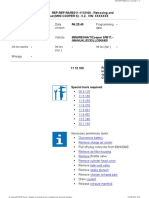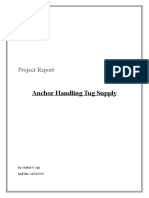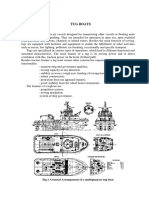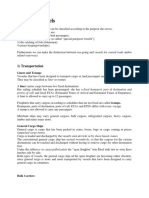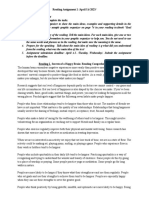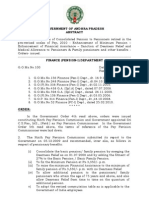0 ratings0% found this document useful (0 votes)
4 viewsOffshore Vessels
Offshore Vessels
Uploaded by
Tanishq GoyalCopyright:
© All Rights Reserved
Available Formats
Download as DOCX, PDF, TXT or read online from Scribd
Offshore Vessels
Offshore Vessels
Uploaded by
Tanishq Goyal0 ratings0% found this document useful (0 votes)
4 views5 pagesCopyright
© © All Rights Reserved
Available Formats
DOCX, PDF, TXT or read online from Scribd
Share this document
Did you find this document useful?
Is this content inappropriate?
Copyright:
© All Rights Reserved
Available Formats
Download as DOCX, PDF, TXT or read online from Scribd
Download as docx, pdf, or txt
0 ratings0% found this document useful (0 votes)
4 views5 pagesOffshore Vessels
Offshore Vessels
Uploaded by
Tanishq GoyalCopyright:
© All Rights Reserved
Available Formats
Download as DOCX, PDF, TXT or read online from Scribd
Download as docx, pdf, or txt
You are on page 1of 5
Offshore Vessels
Offshore vessels are specialized marine ships designed for various tasks related to offshore oil
and gas drilling, oceanic exploration, and support for offshore platforms.
Types and Categories of Offshore Vessels
The offshore industry relies on a variety of specialized vessels for tasks ranging from exploration
to construction. Some of the most famous ones are:
Oil Exploration and Drilling Vessels
Offshore Support Vessels
Offshore Production Vessels
Construction/Special Purpose Vessels
Oil Exploration and Drilling Vessels
Oil Exploration and Drilling Vessels are purpose-built marine ships specifically engineered for
the tasks of hydrocarbon exploration, drilling, and sometimes production. They are usually
equipped with advanced technology, including drilling rigs and navigational systems, to function
efficiently in open water conditions.
Functions of Oil Exploration and Drilling Vessels
The core functions of Oil Exploration and Drilling Vessels are manifold:
Seismic Surveying: These vessels carry out seismic studies to locate possible oil and gas
reserves beneath the ocean floor.
Drilling: Equipped with drilling rigs, these ships drill wells to access hydrocarbon
reserves.
Well Testing and Intervention: Post-drilling, these vessels often handle well testing to
ascertain the reserve’s viability and perform interventions to enhance or restore
productivity.
Types of Oil Exploration and Drilling Vessels
The types of Oil Exploration and Drilling Vessels can be broadly classified into:
Drillships: Highly maneuverable and suited for deep waters, drillships are equipped with
drilling rigs and can relocate without the need for towing.
Semi-submersibles: These are partially submerged vessels that offer a stable drilling
platform, especially useful in rough seas.
Jack-up Rigs: These are mobile drilling platforms with legs that can be lowered to the
seabed to provide stability during drilling operations. They are generally used in
shallower waters.
Offshore barge: is a wide flat bottomed boat that are smaller and designed for short-
distance transportation
Well Intervention Vessel: A dynamically positioned (DP) ship-shaped offshore unit
provided with equipment for well stimulation or maintenance (e.g. coil tubing). Types:-
Light (Perform maintenance on offshore wells) and Heavy (Pump fluids to enhance
productivity)
Offshore Support Vessels
Offshore Support Vessels (OSVs) are an integral category of marine vessels, specifically
designed to assist in the operations of offshore drilling rigs, oil platforms, and other types of
maritime facilities. Unlike Oil Exploration and Drilling Vessels, OSVs are not engaged in the
drilling or production process but rather provide essential support services.
Functions of Offshore Support Vessels
The functions of Offshore Support Vessels are varied but indispensable:
Supply Duties: OSVs are heavily utilized for carrying food, fresh water, fuel, and
equipment to offshore platforms and drilling sites.
Personnel Transportation: They are responsible for ferrying workers to and from
offshore locations.
Anchor Handling: Many OSVs have specialized equipment to manage the anchors for
drilling rigs and production platforms.
Emergency Response: Certain OSVs are equipped for firefighting, oil spill recovery, and
rescue operations, ensuring safety at sea.
Types of Offshore Support Vessels
Platform Supply Vessels (PSV): Primarily used to transport goods and supplies to and
from offshore platforms. Types:- Supply and Firefighting
Anchor Handling Tug Supply (AHTS): Specialized for towing drilling rigs and managing
anchors. Types:- Standard and Multipurpose
Multi-Purpose Support Vessels (MPSV): Versatile vessels that can perform a range of
duties, from supply and anchor handling to sub-sea construction and installation tasks.
Accommodation vessel: They have living quarters, cabins, and usually dining rooms, and
recreation facilities such as a gym.
Seismic survey vessel: maps out geological features in the seabed so that the optimal
location for drilling for oil or gas in the oceans can be pinpointed.
Offshore Production Vessels
They are the heart of the offshore oil and gas industry, housing both production facilities and
crew accommodations. These are the behemoths where the raw hydrocarbons are processed
into usable forms.
The Role of Offshore Production Vessels
Floating Production Systems: With built-in processing plants, OPVs function as mobile
factories, ready to process hydrocarbons right where they're extracted.
Storage and Offloading: Many OPVs have large storage tanks to keep processed oil
before transferring it to tankers or pipelines. This is often denoted by the term 'FPSO,'
which stands for Floating Production, Storage, and Offloading.
Living Quarters: Not only are they production giants, but they also offer living
accommodations for the crew.
Versatility: Some OPVs are versatile enough to be converted into drilling platforms,
especially if a promising reserve is found.
Types of Offshore Production Vessels
Floating Production Systems (FPS): Stationary platforms anchored to the seabed,
optimized for production, but not drilling. Mostly moored in one location for an
extended period
Tension-leg Platforms (TLP): Floating platforms tethered to the seabed in such a way
that they offer both mobility and stability, suitable for deep waters.
SPAR Platforms: These platforms use large cylinders filled with air and water to provide
buoyancy, making them suitable for deeper waters and more volatile sea conditions.
Floating Liquefied Natural Gas (FLNG): Specialized vessels designed to produce and
process liquefied natural gas on the spot, then store it until it can be offloaded onto a
tanker.
Shuttle Tanker: This vessel is equipped with off-loading equipment that is compatible
with the oil field, rig or vessel it works with.
Construction/Special Purpose Vessels
Construction/Special Purpose Vessels may not get the limelight, but these specialized ships are
the backbone of any large-scale offshore project. From laying undersea pipelines to
constructing offshore wind farms, these vessels do it all.
The Role of Construction/Special Purpose Vessels
Pipeline and Cable Laying: Imagine laying down the internet connectivity or oil pipelines
for an entire ocean. These ships do exactly that.
Heavy Lifting and Installation: From installing offshore drilling rigs to setting up wind
turbines, if it's heavy and needs to be in the middle of the ocean, these ships get the
call.
Dive Support and ROV Operations: These ships provide the crucial support needed for
human divers and remotely operated vehicles to perform underwater construction and
maintenance tasks.
Survey and Seismic Operations: Specialized in assessing the seabed and underwater
structures, these vessels play a pivotal role in planning any offshore project.
Types of Construction/Special Purpose Vessels
Crane Vessels: These are the true heavy lifters, equipped with massive cranes for
construction duties.
Pipe-Laying Vessels: Specially designed to lay undersea pipelines, these vessels have
unique onboard facilities to weld, inspect and lay pipes as they go.
Well-Intervention Vessels: These ships are geared toward servicing existing wells to
enhance or restore their productivity.
Diving Support Vessels: These are equipped with saturation diving systems and dynamic
positioning to support deep-sea diving operations. Types:- Surface supplied and
Saturation Diving.
Operating Costs for running a Vessel
The total OPEX of running an offshore vessel is around 5000 USD per day. It
can be further divided into the following heads.
Crew Costs (50%)
Salaries and Wages
Insurance and Benefits
Training and Certification
Crew Rotation and Logistics
Fuel and Lubricants (“expense not borne by the owner)
Fuel Consumption
Lubricant Costs
Maintenance and Repairs (20%)
Scheduled maintenance
Emergency Repairs
Spare Parts
Insurance (10%)
Hull and Machinery Insurance
P&I (Protection and Indemnity) Insurance
Port Fees and Charges (“expense not borne by the owner”)
Berthing Fees
Pilotage Fees
Tonnage Dues
Towage Fees
Provisions and Stores (10%)
Food and Beverage
Cleaning Supplies
Office Supplies
Communications and IT (5%)
Satellite Communications
Regulatory Compliance (5%)
Flag State Fees
Port State Control Inspections
You might also like
- Seam 1 BSMT 1.1 ADocument84 pagesSeam 1 BSMT 1.1 AJanrod Roda100% (4)
- Mini r53 HeadDocument10 pagesMini r53 Headisrael negreteNo ratings yet
- Mapeh 7 Tos Diagnostic Test Sy 2022 2023Document5 pagesMapeh 7 Tos Diagnostic Test Sy 2022 2023FranciscO Pascual100% (1)
- Ship TypesDocument20 pagesShip TypesCatalin Apetre100% (6)
- Basic offshore safety 1Document45 pagesBasic offshore safety 1godstimeogbu5No ratings yet
- Provele Navelor OffshoreDocument8 pagesProvele Navelor OffshoreClaudiu ClawforyouNo ratings yet
- This IS IT!!!!!!!!!!!!!!!!!Document48 pagesThis IS IT!!!!!!!!!!!!!!!!!g k azadNo ratings yet
- Lecture 2 - Types of Ship and DesignsDocument100 pagesLecture 2 - Types of Ship and DesignsiamtawhidhassanNo ratings yet
- Types of ShipsDocument11 pagesTypes of ShipsJohn BernalNo ratings yet
- LECTURE No.6: Anchor Handlers or Anchor Handling Vessels (AHV) Is Very Powerful Ships ThatDocument12 pagesLECTURE No.6: Anchor Handlers or Anchor Handling Vessels (AHV) Is Very Powerful Ships ThatMiruna ClinciuNo ratings yet
- Class 1Document36 pagesClass 1Aktarojjaman MiltonNo ratings yet
- Semi SubmersibleDocument23 pagesSemi SubmersibleSrinivasan Rajenderan100% (1)
- Ship's NomenclatureDocument21 pagesShip's NomenclatureGennieNo ratings yet
- Macam Dan Jenis Kapal Kapal Serta Fungsi Yg Ada Di Dunia PelayaranDocument8 pagesMacam Dan Jenis Kapal Kapal Serta Fungsi Yg Ada Di Dunia Pelayarananon_274187236No ratings yet
- PSSR FinDocument114 pagesPSSR FinIndrakanth KrishNo ratings yet
- Shipping Aspects & Types of Ship 30.01.2024Document8 pagesShipping Aspects & Types of Ship 30.01.2024devmarineacademyNo ratings yet
- Types of Ships-1Document4 pagesTypes of Ships-1jackyNo ratings yet
- Curs Nav I, s2Document41 pagesCurs Nav I, s2Mitea Gabriel-CristianNo ratings yet
- Macam Dan Jenis KapalDocument7 pagesMacam Dan Jenis KapalaangNo ratings yet
- Type of ShipsDocument22 pagesType of ShipsAllison100% (1)
- Macam Dan Jenis Kapal Kapal Serta Fungsi Yg Ada Di Dunia PelayaranDocument7 pagesMacam Dan Jenis Kapal Kapal Serta Fungsi Yg Ada Di Dunia PelayaranRoy KeloNo ratings yet
- Jenis Jenis Kapal Dalam Dunia MaritimDocument7 pagesJenis Jenis Kapal Dalam Dunia MaritimYan FerizalNo ratings yet
- Production InstallationsDocument18 pagesProduction InstallationsPrasanna Kumar100% (1)
- Advanced Offshore Engineering Notes For Petrochem BranchDocument91 pagesAdvanced Offshore Engineering Notes For Petrochem BranchVikas Katiyar100% (1)
- Marine Communication EquipmentDocument18 pagesMarine Communication EquipmentMenly Susada100% (1)
- 13 Types of VesselsDocument41 pages13 Types of VesselsCornelia Theodora67% (3)
- Ship Construction and Structure by Azaruddin MominDocument147 pagesShip Construction and Structure by Azaruddin MominNaman joshi100% (3)
- Lesson Types 9Document12 pagesLesson Types 9Куринаки КириллNo ratings yet
- Ceva EnglezaDocument17 pagesCeva EnglezagabytzustefanNo ratings yet
- What are Offshore Vessels_Document7 pagesWhat are Offshore Vessels_prathamNo ratings yet
- Maritime 2 FinalDocument24 pagesMaritime 2 Finalapi-274582842No ratings yet
- The Drilling Rig Type: University of Khartoum Faculty of Engineering: Petroleum and Natural Gas DepartmentDocument7 pagesThe Drilling Rig Type: University of Khartoum Faculty of Engineering: Petroleum and Natural Gas DepartmentJo odNo ratings yet
- Cargo Operation AssignmentDocument27 pagesCargo Operation AssignmentAseel Najeeb AlmasholyNo ratings yet
- Factors Influencing The Feasibility of Port ConstructionDocument2 pagesFactors Influencing The Feasibility of Port ConstructionBeah Francia De la CruzNo ratings yet
- Seam2 Week 2Document28 pagesSeam2 Week 2justine arenasNo ratings yet
- Undergraduate English Course For Marine Engineers: Tomislav Skračić, MADocument15 pagesUndergraduate English Course For Marine Engineers: Tomislav Skračić, MAAkash KunduNo ratings yet
- GSK 3Document14 pagesGSK 3KannanNo ratings yet
- Design of Offshore PlatformDocument16 pagesDesign of Offshore PlatformMd Azahary100% (3)
- Presentation Part 1Document142 pagesPresentation Part 1Daniel InemughaNo ratings yet
- Harbour EngineeringDocument64 pagesHarbour EngineeringshankaregowdaNo ratings yet
- Design of Floating Offshore Platform: January 2021Document29 pagesDesign of Floating Offshore Platform: January 2021vucokt100% (2)
- Recap: - Port: - Harbour: - There Are Ports That Are Not Sheltered and Harbours That Have No Ports. - RoadsteadDocument25 pagesRecap: - Port: - Harbour: - There Are Ports That Are Not Sheltered and Harbours That Have No Ports. - Roadsteadlance carterNo ratings yet
- My SeminarDocument57 pagesMy SeminarAbhishek GauravNo ratings yet
- Oil Platform TypesDocument2 pagesOil Platform TypesandrejluigiNo ratings yet
- Ship Classification and TypesDocument15 pagesShip Classification and TypesPandu Prayoga HoppusNo ratings yet
- Types of ShipsDocument42 pagesTypes of ShipsSeçkin DilekNo ratings yet
- LECTURE No.7: Tugs (Or Tug Boats) Are Vessels Designed For Maneuvring Other Vessels or Floating UnitsDocument17 pagesLECTURE No.7: Tugs (Or Tug Boats) Are Vessels Designed For Maneuvring Other Vessels or Floating UnitsMiruna Clinciu100% (1)
- Drydocking NotesDocument162 pagesDrydocking Noteschauhandeepak543No ratings yet
- CH 02Document56 pagesCH 02Nestor OlNo ratings yet
- Harbour and Jetty StructuresDocument76 pagesHarbour and Jetty StructuresKhrl K Khrl96% (57)
- DRY DOCKS - An OverviewDocument39 pagesDRY DOCKS - An OverviewDyal AdityaNo ratings yet
- HARBOURDocument36 pagesHARBOURGopi Raju50% (2)
- Offshore Engineering For Structural EngineersDocument43 pagesOffshore Engineering For Structural Engineerskunlef91% (11)
- Offshore PlatformDocument7 pagesOffshore PlatformbaratkumrNo ratings yet
- Type of VesselsDocument5 pagesType of VesselsIvanKonjevicNo ratings yet
- Ifr em I, 2 U1Document10 pagesIfr em I, 2 U1Cosmin IulianNo ratings yet
- Marine Logistics including Liquid Cargo and Bulk CargoFrom EverandMarine Logistics including Liquid Cargo and Bulk CargoRating: 3 out of 5 stars3/5 (1)
- Autonomous Underwater Vehicle: Stealth Technology and Tactical Advancements in Modern Naval WarfareFrom EverandAutonomous Underwater Vehicle: Stealth Technology and Tactical Advancements in Modern Naval WarfareNo ratings yet
- Setting Sail: Your First-Time Cruisers Guide: Xtravix Travel Guides, #1From EverandSetting Sail: Your First-Time Cruisers Guide: Xtravix Travel Guides, #1Rating: 5 out of 5 stars5/5 (1)
- Efisiensi Energy Kel.1Document7 pagesEfisiensi Energy Kel.1Natalyas MarampaNo ratings yet
- Géstion Des DéchetsDocument11 pagesGéstion Des DéchetsNoura AzaouagNo ratings yet
- Manufacturing of Acetone From Isopropanol (P&ID)Document1 pageManufacturing of Acetone From Isopropanol (P&ID)Ali KimNo ratings yet
- OpTransactionHistory18 08 2021Document9 pagesOpTransactionHistory18 08 2021Deepak UpadhayayNo ratings yet
- Larson Chap 1 Prob Set ADocument17 pagesLarson Chap 1 Prob Set AJack ThuanNo ratings yet
- Overview BenefitsDocument5 pagesOverview BenefitsRobert IosifNo ratings yet
- Manual: Model W-075Document3 pagesManual: Model W-075Carlos BenitezNo ratings yet
- Journaling Jar Prompts For EntrepreneursDocument10 pagesJournaling Jar Prompts For EntrepreneursTapas BanerjeeNo ratings yet
- Chapter Five Inclusion For Peace, Democracy, and DevelopmentDocument26 pagesChapter Five Inclusion For Peace, Democracy, and Developmentdawit100% (1)
- PH Games. Week 2Document3 pagesPH Games. Week 2Nicholas Bonn SingNo ratings yet
- Performance AppraisalDocument103 pagesPerformance AppraisalKishore Addagabottu100% (2)
- BartendingDocument94 pagesBartendingAngeline Garcia100% (2)
- Unofficial Guide To Passing You Ros Ces Candidate BriefingskkDocument30 pagesUnofficial Guide To Passing You Ros Ces Candidate BriefingskkMariaBrincat0% (4)
- Construction Materials: Assignment ReportDocument7 pagesConstruction Materials: Assignment ReportKiệt ĐỗNo ratings yet
- Anne Sullivan: Early ChallengesDocument8 pagesAnne Sullivan: Early ChallengeslyubovshankarNo ratings yet
- Boq - Ele-Solar Dr. Aunty MayDocument2 pagesBoq - Ele-Solar Dr. Aunty MaySai Aung Naing MyintNo ratings yet
- PesenanDocument4 pagesPesenanAde HariyanaNo ratings yet
- 1º Forum Angola-Ruanda - Apresentação AIPEXDocument24 pages1º Forum Angola-Ruanda - Apresentação AIPEXsye consultoriaNo ratings yet
- Semester IDocument17 pagesSemester IMohit PadheeNo ratings yet
- The Tradition of Baralek Gadang - Saskia Putri NabillaDocument3 pagesThe Tradition of Baralek Gadang - Saskia Putri NabillaSaskia Putri NabillaNo ratings yet
- SLS134 BassaDocument377 pagesSLS134 Bassaapi-3769211100% (2)
- Campus Climate Survey - Preliminary Results ReportDocument203 pagesCampus Climate Survey - Preliminary Results ReportKacey GardnerNo ratings yet
- Thesis Topics For Radiologic TechnologyDocument5 pagesThesis Topics For Radiologic Technologyiapesmiig100% (1)
- TTA Sublimation InkDocument4 pagesTTA Sublimation Inkde_kurNo ratings yet
- Petit Seminaire ST Leon Kabgayi B.P: 66 Gitarama (Muhanga) Covid-19 Holiday'S Evaluations-JulyDocument2 pagesPetit Seminaire ST Leon Kabgayi B.P: 66 Gitarama (Muhanga) Covid-19 Holiday'S Evaluations-JulyWilly LandryNo ratings yet
- Chemistry Urt ExamDocument9 pagesChemistry Urt ExamAmira AbdallahNo ratings yet
- Reading Assignment-1 2023Document9 pagesReading Assignment-1 2023Sainjargal GantuyaNo ratings yet
- Minimum Pension PRC 2010 ... GO100Document246 pagesMinimum Pension PRC 2010 ... GO100SEKHAR100% (5)

